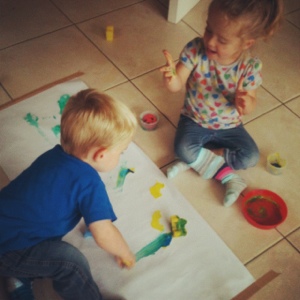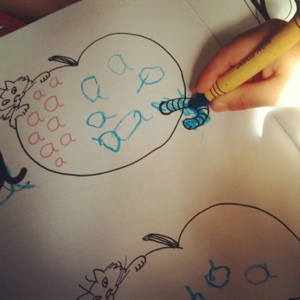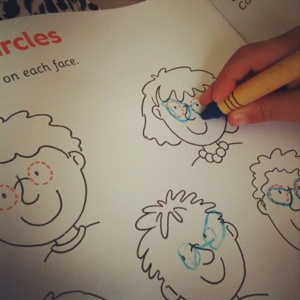Writing is an essential life skill that the majority of littlies eventually achieve but when should you start to encourage your littly to do it?
By 18 months, many littlies are able to hold a crayon and scribble on paper. Some are even able to make a few letters such as ‘O’ or ‘L’ by the time they are 3 years old, and some may even be able to write their name. However, as with all development, children develop at different rates so don’t worry if your little one isn’t writing their first novel just yet!
Older littlies (2+) will often do ‘writing’ during role play in an attempt to copy grown-ups so it’s always a good idea to provide writing materials such as chalk, crayons, and pencils, to encourage this kind of role play writing.
As your littly becomes aware of written letters through books or computers it’s important to grasp this awareness and encourage and support their learning.
Top Tips to introducing writing to toddlers…
- Invest in notepads, pencils and letter books to enable your child to have a good foundation for writing and also reading.
- In order to read and write, your littly must first understand letters. That is that letters on their own make sounds and that groups of letters together make words. So invest in letter books, magnetic letters or make your own letter flash cards.
- Practice the letter sounds together in a fun way rather than boring letter repetition! For example A is for Apple but it’s also for Aligator (chase each other around the room) Ants (tickle time!) and Aeroplane (zoom around the room!)
- Provide opportunities for your littly to develop the physical skills needed for writing. Before they can control a pencil they must develop hand eye and motor coordination in their little hands. Games such as
 tower building with blocks, fingerprinting, play dough, and simple pop-in jigsaws will help develop this.
tower building with blocks, fingerprinting, play dough, and simple pop-in jigsaws will help develop this.
- Have regular ‘drawing’ sessions to ensure you’re encouraging crayon/pencil control at least once a week at this early stage. Draw faces and ask your littly to add glasses or hair- a fun way of using pencil control.
- Keep crayons and pencils easily accessible but don’t make my mistake of leaving markers around! We ended yp eith a nicely decorated kitchen wall!
- Encourage your littly to use to scribble, draw lines and shapes on paper. These first pictures, are the very beginning of writing even if they look far from it to begin with.
- Communicate with your littlies when they’re drawing – ask what they are writing about during role play drawing or what picture they have drawn. Encourage their ideas and imagination but don’t take over.
- Introduce your littly to their first name. This can be written or printed or through magnetic letters. Talk about their name, count how many letters are in their name and look at the shapes of the letter. For example O is for Oscar but O is also for Orange.
- Display your little ones work proudly- this enables you and them to talk about the work regularly.
- Have letter days! An A day would involve looking for things beginning with S, eating S food (Sausages, spaghetti, sauce) and wearing S clothes! (shorts, skirts, shirts!)
- Don’t go overboard! - While learning is important-it’s essential that it’s fun. Don’t spend hours writing in letter books or practicing letter names, boredom doesn’t encourage learning.
- Encourage learning at a good time! Avoid bedtimes and just before nap-times when your littly is tired and probably grumpy. After breakfast is a great time to learn, especially on a dull rainy day!




Recent comments